Aland Island Eye Disease with Retinoschisis in the Clinical Spectrum of CACNA1F-Associated Retinopathy-A Case Report
- PMID: 38474172
- PMCID: PMC10931673
- DOI: 10.3390/ijms25052928
Aland Island Eye Disease with Retinoschisis in the Clinical Spectrum of CACNA1F-Associated Retinopathy-A Case Report
Abstract
Aland island eye disease (AIED), an incomplete form of X-linked congenital stationary night blindness (CSNB2A), and X-linked cone-rod dystrophy type 3 (CORDX3) display many overlapping clinical findings. They result from mutations in the CACNA1F gene encoding the α1F subunit of the Cav1.4 channel, which plays a key role in neurotransmission from rod and cone photoreceptors to bipolar cells. Case report: A 57-year-old Caucasian man who had suffered since his early childhood from nystagmus, nyctalopia, low visual acuity and high myopia in both eyes (OU) presented to expand the diagnostic process, because similar symptoms had occurred in his 2-month-old grandson. Additionally, the patient was diagnosed with protanomalous color vision deficiency, diffuse thinning, and moderate hypopigmentation of the retina. Optical coherence tomography of the macula revealed retinoschisis in the right eye and foveal hypoplasia in the left eye. Dark-adapted (DA) 3.0 flash full-field electroretinography (ffERG) amplitudes of a-waves were attenuated, and the amplitudes of b-waves were abolished, which resulted in a negative pattern of the ERG. Moreover, the light-adapted 3.0 and 3.0 flicker ffERG as well as the DA 0.01 ffERG were consistent with severely reduced responses OU. Genetic testing revealed a hemizygous form of a stop-gained mutation (c.4051C>T) in exon 35 of the CACNA1F gene. This pathogenic variant has so far been described in combination with a phenotype corresponding to CSNB2A and CORDX3. This report contributes to expanding the knowledge of the clinical spectrum of CACNA1F-related disease. Wide variability and the overlapping clinical manifestations observed within AIED and its allelic disorders may not be explained solely by the consequences of different mutations on proteins. The lack of distinct genotype-phenotype correlations indicates the presence of additional, not yet identified, disease-modifying factors.
Keywords: AIED; Aland island eye disease; CACNA1F; Cav1.4; retinoschisis.
Conflict of interest statement
Author Adrian Smędowski was employed by the company GlaucoTech Co. The remaining author declares that the research was conducted in the absence of any commercial or financial relationships that could be construed as a potential conflict of interest.
Figures




Similar articles
-
A Novel Splice-Site Variant in CACNA1F Causes a Phenotype Synonymous with Åland Island Eye Disease and Incomplete Congenital Stationary Night Blindness.Genes (Basel). 2021 Jan 27;12(2):171. doi: 10.3390/genes12020171. Genes (Basel). 2021. PMID: 33513752 Free PMC article.
-
A novel p.Gly603Arg mutation in CACNA1F causes Åland island eye disease and incomplete congenital stationary night blindness phenotypes in a family.Mol Vis. 2011;17:3262-70. Epub 2011 Dec 15. Mol Vis. 2011. PMID: 22194652 Free PMC article.
-
Mosaic synaptopathy and functional defects in Cav1.4 heterozygous mice and human carriers of CSNB2.Hum Mol Genet. 2014 Mar 15;23(6):1538-50. doi: 10.1093/hmg/ddt541. Epub 2013 Oct 26. Hum Mol Genet. 2014. PMID: 24163243 Free PMC article.
-
Aland Island eye disease (Forsius-Eriksson syndrome) associated with contiguous deletion syndrome at Xp21. Similarity to incomplete congenital stationary night blindness.Arch Ophthalmol. 1989 Aug;107(8):1170-9. doi: 10.1001/archopht.1989.01070020236032. Arch Ophthalmol. 1989. PMID: 2667510 Review.
-
Cav1.4 dysfunction and congenital stationary night blindness type 2.Pflugers Arch. 2021 Sep;473(9):1437-1454. doi: 10.1007/s00424-021-02570-x. Epub 2021 Jul 1. Pflugers Arch. 2021. PMID: 34212239 Free PMC article. Review.
Cited by
-
A New Phenotypic Expression in a Patient With a Mutation in the CACNA1F Gene.Cureus. 2025 Apr 19;17(4):e82577. doi: 10.7759/cureus.82577. eCollection 2025 Apr. Cureus. 2025. PMID: 40390739 Free PMC article.
References
-
- Hove M.N., Kilic-Biyik K.Z., Trotter A., Grønskov K., Sander B., Larsen M., Carroll J., Bech-Hansen T., Rosenberg T. Clinical Characteristics, Mutation Spectrum, and Prevalence of Åland Eye Disease/Incomplete Congenital Stationary Night Blindness in Denmark. Investig. Ophthalmol. Vis. Sci. 2016;57:6861–6869. doi: 10.1167/iovs.16-19445. - DOI - PMC - PubMed
-
- De Silva S.R., Arno G., Robson A.G., Fakin A., Pontikos N., Mohamed M.D., Bird A.C., Moore A.T., Michaelides M., Webster A.R., et al. The X-linked retinopathies: Physiological insights, pathogenic mechanisms, phenotypic features and novel therapies. Prog. Retin. Eye Res. 2021;82:100898. doi: 10.1016/j.preteyeres.2020.100898. - DOI - PubMed
Publication types
MeSH terms
Substances
Supplementary concepts
LinkOut - more resources
Full Text Sources
Medical

